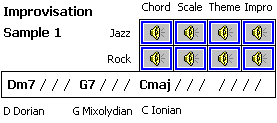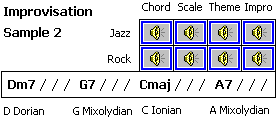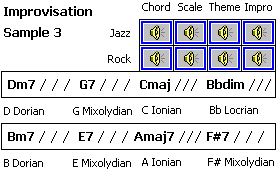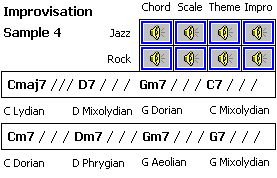(8.8) Improvisation Examples
Now we're going to see the modes of the Major scale in action with some sample improvisations over a few different chord progressions. Each is designed to be 'circular', so that the last chord works as a lead back into the first chord again for repeated playing.
Each progression is illustrated in two different styles - a gentle jazz style, and a heavier, faster rock style. To help you analyse the sound of each improvisation, there are four formats available for each of these.
- Chord is the chord progression only
- Scale is the chord progression with straight scales
- Theme is a short repeated theme within each scale
- Impro is a single random improvisation throughout
We start with a simple three chord sequence, which is basically a II-V-I progression in the C Major scale. Even without knowing this, we can find scale modes for each chord, in this case the common choices of Dorian for the IIm7, Mixolydian for the V7 and Ionian for the Imaj.

Next we'll take the same progression, but give it a bit of a twist at the end by substituting an A7 (creating a new D minor key centre) to lead more strongly back into the Dm7 at the start.

The next progression is twice as long, and more harmonically complex than the previous two. Note the similarity of the two lines, both are still II-V-I progressions, but the first is in C Major while the second is in a different key centre of A Major.
The B♭dim and F♯7 chords create a tension which allows a sense of release when the harmony moves from one key centre to the other. Diminished and dominant seventh chords are often used for bridging key centres like this.
Note the appearance of the Locrian scale to support the B♭dim chord.

The last progression is also based on a different key centre each line, and features the Lydian and Phrygian modes. While we mentioned before that these two are less common, they serve an important purpose here.
The C Lydian and D Mixolydian reinforce each other before the harmony resolves to Gm7 in the first row, while the C Dorian and D Phrygian combination serves the same role in the second row.

If it's not clear to you why we have chosen particular modes throughout this topic, don't worry about it. The rules are not black and white, and our intention here is simply to provide some examples to get you started.
The main thing is to have a good understanding of which scale modes are possible choices and why. Your developing sense of harmony should be the ultimate judge, as your ear becomes more finely tuned to the subtle differences between them.
|
Topic 103 of 117
| ||
Bring these music concepts to life with the free Songtrix Bronze Edition as you create songs from chords and scales.
Then publish and share your ideas with the other musicians you meet on the ChordWizard Network.
Have questions? Join the ChordWizard Network and post them in the Music Theory forum for answers and discussions on your topics of interest.








